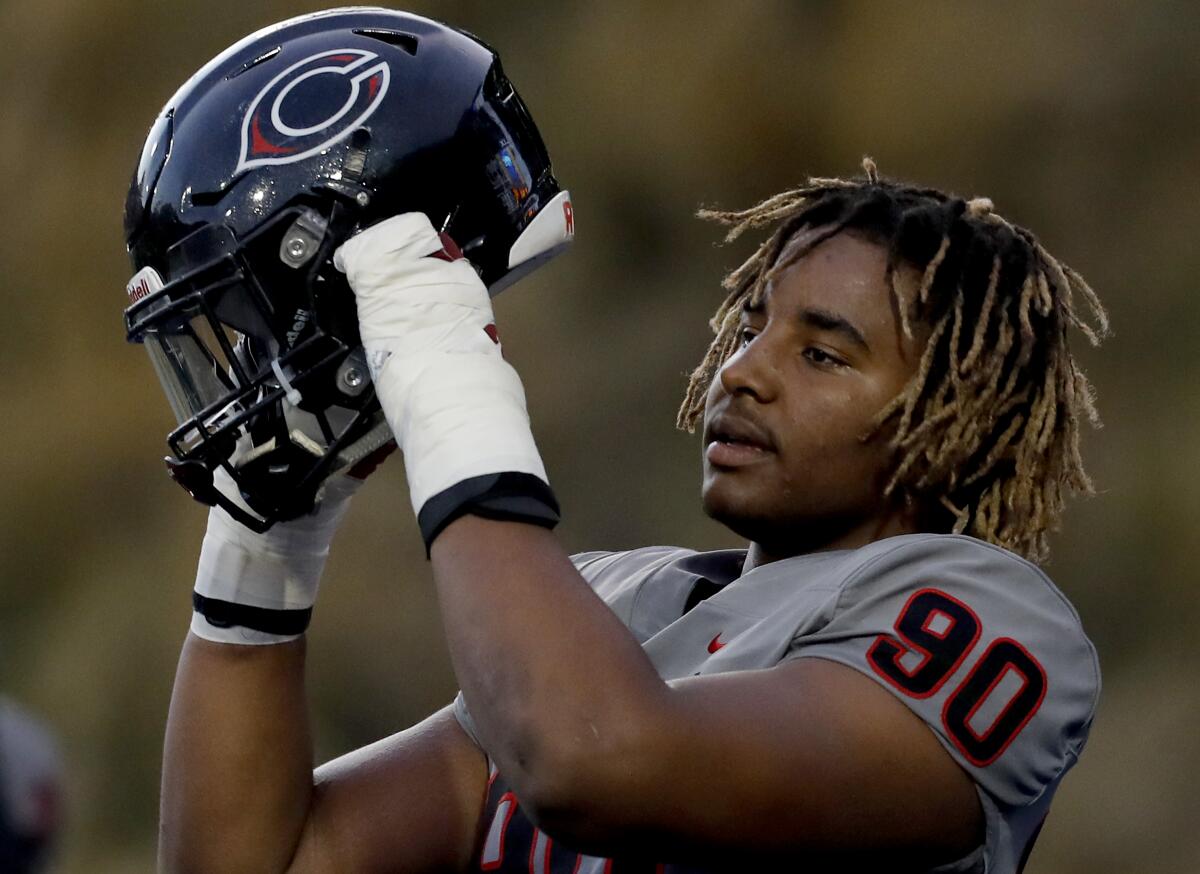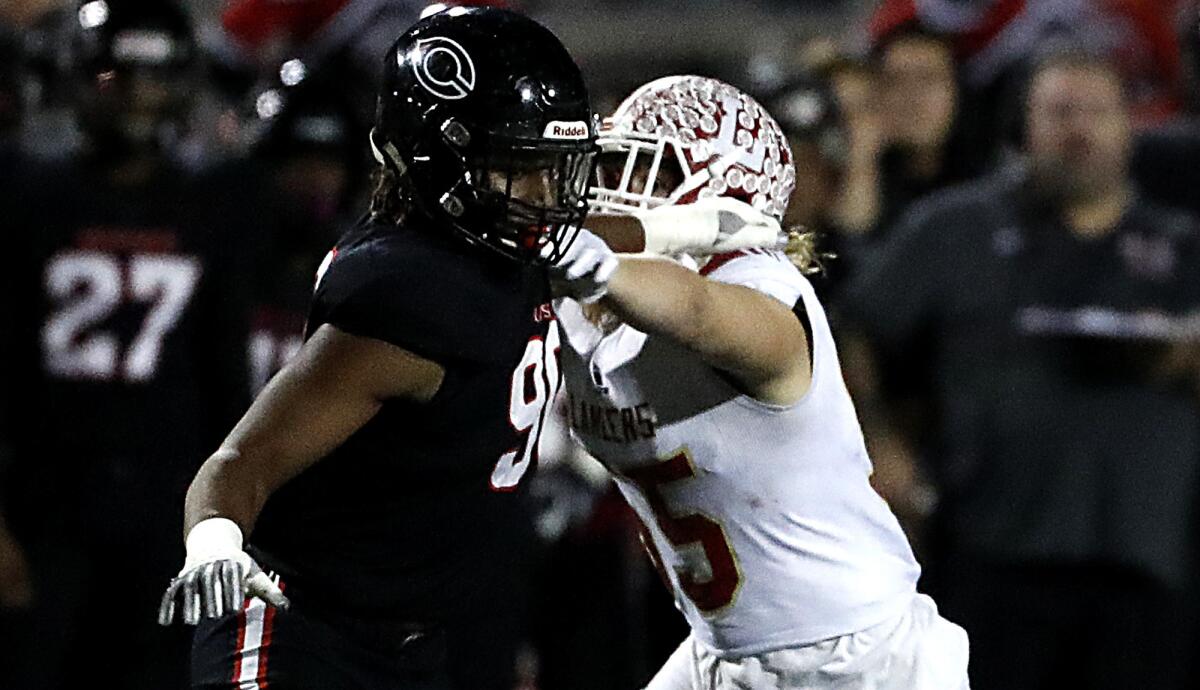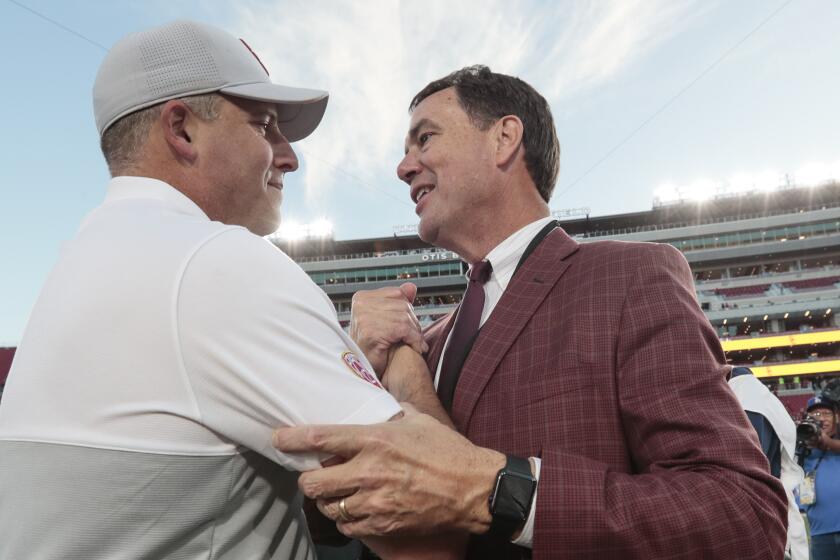In order to land Korey Foreman, USC had to be ‘relentless’

- Share via
After nearly a year of daily texts and phone calls and in-depth FaceTime conversations, Donte Williams felt pretty good about where he stood with the nation’s No. 1 overall recruit. Then, all of a sudden, Korey Foreman went dark.
USC’s top recruiter and cornerbacks coach had spent his short Trojans tenure developing a close relationship with the Corona Centennial High defensive end. On a revamped defensive staff, Williams was the only new assistant who’d actually met Foreman in person before the pandemic.
So it stood to reason he was the Trojans’ best hope of delivering the potential program-altering prospect.
Now, in the final stretch of the most critical recruitment in recent memory at USC, Williams began to wonder: Am I seriously being ghosted?
“I’m sending him 10, 15 text messages a day,” Williams said, laughing as he realized how it sounds. “I’m calling him three, four times per day. And he’s responding with one word. I’m here like, ‘Dang.’ Korey was the guy who, if I sent one text, he’d write back a paragraph.”
While USC’s fans might wonder why Clay Helton isn’t gone yet, Mike Bohn’s decision to keep the beleaguered football coach might be part of a bigger plan.
Williams kept texting. “It didn’t matter he wasn’t responding,” he said. “I was going 110% until I knew.”
Only a few at USC knew at that point that Foreman had signed his national letter of intent on the last day of the early signing window in December, becoming the first top-rated recruit in 247Sports’ rankings to join the Trojans in more than a decade.
His clandestine signing would seal the most significant recruiting victory of the Clay Helton era, helping to validate the effort made by USC’s new regime to overhaul and reimagine its recruiting operation.
But for two weeks, no one outside of Helton and a couple other staffers had any idea.
It was exactly how Foreman intended to quietly wrap up a whirlwind recruitment that also included such powerhouses as Clemson, Louisiana State and Georgia. Mostly, he just wanted to make Williams sweat it out until the end.
At USC, everyone understood the stakes. Following a 2020 class that bottomed out at 64th overall in the national rankings, the department’s new leadership set out to rebuild a recruiting operation that had been understaffed and overtaxed and refocus its vision.
They added support staffers with expertise in graphics and video and built an in-house creative studio focused on personal branding.
All with the intention of convincing top recruits like Foreman that there was no better place to become a star.
“We wanted to be on the frontline of innovation,” Helton said.
Perhaps most importantly, USC hired Williams, who would play an integral role not only in inking Foreman, but also eight other prospects in the class of 2021.
Williams met Foreman on an unofficial campus visit as Oregon’s cornerbacks coach. Gavin Morris, the Trojans’ director of player development, was the only other staffer who knew the five-star prospect all that well.
But before USC could finalize its defensive staff, Foreman committed to Clemson.
It had been five years since a prospect reneged on a commitment to Tigers coach Dabo Swinney. Still, Williams went about slowly building trust with Foreman. They talked most days, often about anything but football. “Our personalities just kind of gravitated to each other,” Williams said.
Once that trust was earned, Foreman shared his concerns about USC. He asked about the new defense and the direction of the program. He had doubts about whether he wanted to stay close to home or leave for a proven powerhouse in the South.
USC had watched other top prospects leave the Southland in recent years with similar questions. Former Santa Ana Mater Dei quarterback and No. 1 overall recruit Bryce Young was committed to the Trojans for more than a year before flipping to Alabama in 2020.
Westlake Village Oaks Christian defensive end Kayvon Thibodeaux, the top player in the state and No. 2 player overall in 2019, spurned USC for Oregon.
“He had a lot of questions,” Williams said of Foreman. “Where would he fit in not just schematically, but as a person? How could he grow?”

USC already set out to answer those lingering questions, when Foreman decommitted from Clemson in late April. Over the eight months that followed, Foreman said, the Trojans’ staff was “completely relentless.”
Aware of the program’s recent misses in recruiting, the coaches saw Foreman as essential to turning things around.
The pandemic kept Foreman from taking official visits elsewhere, where other programs could roll out the red carpet. But it also complicated the process of convincing him of USC’s plans, which weren’t yet fully realized.
Defensive coordinator Todd Orlando and defensive line coach Vic So’oto worked to forge relationships with Foreman, selling him on his fit within USC’s new scheme, despite never having met him in person.
Almost every day, the staff was briefed on whatever happened the previous day with its top target.
“It was point No. 1,” So’oto said. “We had updates about conversations he had throughout the building every day. We knew if we were going to take the step we wanted to take, that the No. 1 player being right down the road was objective No. 1.”
The objective might have never been reached if the Pac-12 hadn’t played its season.
“I needed to see the progression from the SC staff,” Foreman said. “I needed to see what all they were doing and fixing from recent years and everything they had going on.”
USC went 5-1, losing to Oregon in the Pac-12 title game. But Foreman saw what he needed to see from the Trojans’ defensive line, which made a significant leap under So’oto’s watch.
The staff had another pitch in its back pocket. Foreman had made clear that developing his personal brand was important to his decision. So USC prepared an in-depth presentation over Zoom in December, focused on the star power of Los Angeles and the lucrative opportunities that would be available to him, once the floodgates open on name, image and likeness for college athletes.
Foreman called it “insane.” USC had laid out concrete data to quantify his branding potential and the reach of its own brand, from engagement rates to expected dollars per Instagram post. They offered strategies for improving his Instagram following and explained how former Trojans receiver Juju Smith-Schuster, who boasts a huge online audience as a member of the Pittsburgh Steelers, might’ve cashed in as a marketable college star.
“Going into being a college athlete, this is everything that people talk about wanting to have,” Foreman said. “Everybody feels like college athletes deserve something at some point, and I couldn’t be the only one that was drooling when they talked about the numbers.”
USC’s entire name, image and likeness operation had been constructed with Foreman and future recruits in mind. His signing felt to USC’s staff like a validation of that vision.
“It was a perfect fit,” said Spencer Harris, the Trojans’ director of player personnel. “The adjustments we made in this last year all add up to this being the perfect place for Korey Foreman to sign.”
On Dec. 18, the day of the Pac-12 title game, Harris received a phone call from Morris shortly after midnight. “He was freaking out,” Harris recalled.
The Foremans were on the line. “He’s ready to go right now,” Morris told him.
So Harris found himself praying that Kyle Siemer, USC’s football compliance officer, was still awake to verify Foreman’s paperwork. In a fortunate twist, Siemer answered his phone and Foreman was officially signed.
“The No. 1 player in the country, a player in our backyard, the shift in what he represents and what he means for bringing USC football back to where we want it to be, it’s just monumental,” Harris said.
Korey Foreman, the defensive end from Corona Centennial High, announced his decision to attend USC on national television Saturday.
Helton awoke to the news in the morning. But for another two weeks, the few who knew sat on the huge secret.
So’oto was driving to a wedding Saturday when that reveal finally happened on national television. He streamed the announcement on a phone, with his five kids listening intently in the car, well aware of who “Korey” was by this point. When Foreman announced for USC, the car erupted with screams and cheers.
So’oto is already thinking of ways he might move Foreman around the defense next fall. “Wherever there’s a weakness, we’re going to put him,” So’oto said.
Williams, who like Soto was unaware of Foreman’s plans, could barely contain his excitement as he watched. He’d been promoted to associate head coach, in part, for his work reeling in Foreman and other recruits. And now the moment he’d been working for had finally arrived. USC had landed the top prospect in the land, vaulting to No. 8 in the recruiting rankings.
It was mere seconds after affixing his USC cap to his head that Foreman was on FaceTime with Williams, his ghosting sentence finally over.
“He was like, ‘I had you, I had you!’ ” Williams said.
More to Read
Go beyond the scoreboard
Get the latest on L.A.'s teams in the daily Sports Report newsletter.
You may occasionally receive promotional content from the Los Angeles Times.









